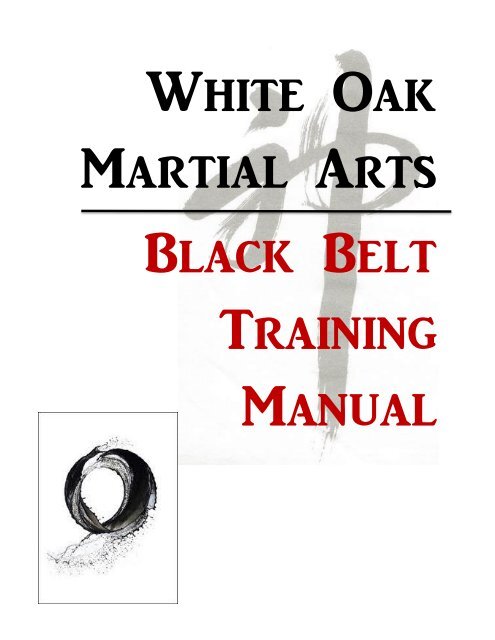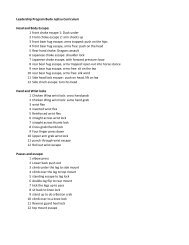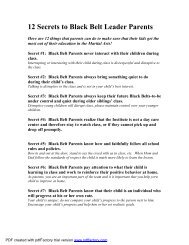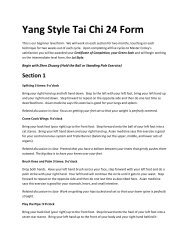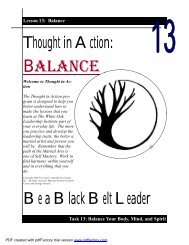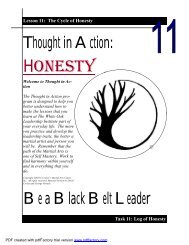Black Belt Training Manual - The White Oak Martial Arts Center
Black Belt Training Manual - The White Oak Martial Arts Center
Black Belt Training Manual - The White Oak Martial Arts Center
You also want an ePaper? Increase the reach of your titles
YUMPU automatically turns print PDFs into web optimized ePapers that Google loves.
<strong>White</strong> <strong>Oak</strong><br />
<strong>Martial</strong> <strong>Arts</strong><br />
<strong>Black</strong> <strong>Belt</strong><br />
<strong>Training</strong><br />
<strong>Manual</strong>
How <strong>Belt</strong>s and Tips Work<br />
Age Levels of <strong>Black</strong> <strong>Belt</strong>.<br />
<strong>The</strong>re are three different age levels of <strong>Black</strong> <strong>Belt</strong>s. Youth <strong>Black</strong> <strong>Belt</strong>s are students<br />
who are under 10. Junior <strong>Black</strong> <strong>Belt</strong>s are students under 16. Adult <strong>Black</strong> <strong>Belt</strong>s,<br />
or Dan Rankings are students over 16. It is possible to earn higher degrees of <strong>Black</strong><br />
<strong>Belt</strong> no matter which level you are.<br />
Any higher age level is a higher rank than a lower age level, regardless of degree.<br />
For example, a 1 st degree adult <strong>Black</strong> <strong>Belt</strong> is a higher rank then a 4 th degree junior<br />
<strong>Black</strong> <strong>Belt</strong>. When a student comes of age, he or she is welcome and encouraged to<br />
test for the next age level ranking. Students do not need to begin again at white belt<br />
to level up.<br />
Tips and testing for <strong>Black</strong> <strong>Belt</strong>s.<br />
<strong>Black</strong> <strong>Belt</strong> students get one black tip for every class and ten black tips equals one<br />
blue tip. Four Blue tips mean that you are ready for a red tip test.<br />
10 black tips 1 blue tip<br />
4 blue tips 1 red tip<br />
<strong>The</strong> number of red tips required to get your next belt depends upon which rank you<br />
are. Here are the minimum attendance and time requirements:<br />
1 st to 2 nd degree <strong>Black</strong> <strong>Belt</strong> (20 months minimum) 4 red tips<br />
2 nd to 3 rd degree <strong>Black</strong> <strong>Belt</strong> (30 months minimum) 6 red tips<br />
3 rd to 4 th degree <strong>Black</strong> <strong>Belt</strong> (40 months minimum) 8 red tips<br />
4 th to 5 th degree <strong>Black</strong> <strong>Belt</strong> (50 months minimum) 10 red tips<br />
5 th to 10 th degree <strong>Black</strong> <strong>Belt</strong>s are for instructors based upon contribution and merit.<br />
However, showing up is just part of getting your next belt. You also need to be<br />
able to do stuff.
Requirements for Red Tips.<br />
Below you’ll find a complete listing of Lessons In Mastery Tasks. <strong>The</strong>se are<br />
required for each red tip. <strong>The</strong>re will also be a physical test during the <strong>Black</strong> <strong>Belt</strong><br />
class. <strong>The</strong> physical test will be on whatever we have been working on in class.<br />
You will be required to do a form of your choice, self-defense application, and<br />
sparring. You will also be testing on how well you are progressing with the secrets<br />
of internal power.<br />
Requirements for your next degree of <strong>Black</strong> <strong>Belt</strong>.<br />
For each degree of <strong>Black</strong> <strong>Belt</strong>, you will be required to complete a <strong>Black</strong> <strong>Belt</strong><br />
Challenge, exactly like you did for your first degree. You will not have to<br />
complete a written exam for higher degrees, but you will have to do a physical<br />
exam and a Lessons in Mastery Task. For the physical exam you will have to do<br />
a form, application, and sparring at a level of performance adequate for the rank<br />
you are testing for.<br />
Lessons in Mastery<br />
For more detailed information on these items go to the <strong>Black</strong> <strong>Belt</strong> page on<br />
www.<strong>White</strong><strong>Oak</strong><strong>Martial</strong><strong>Arts</strong>.com.<br />
1st Degree <strong>Black</strong> <strong>Belt</strong><br />
1. Red Tip 1: Compassion. Learn the Charter of Compassion.<br />
2. Red Tip 2: Mastery. Document a Real Master. What does Mastery mean?<br />
3. Red Tip 3: Commitment. Do the Daily Dozen every day for 30 days.<br />
4. Red Tip 4: Service Project. Lead a Community Service Project.<br />
2nd Degree <strong>Black</strong> <strong>Belt</strong><br />
5. Red Tip 1: Education. Obtain certification in first aid, CPR, etc.<br />
6. Red Tip 2: Belief. Read a book on philosophy or scripture.<br />
7. Red Tip 3: Dedication. Run a 5k or another similar physical feat.<br />
8. Red Tip 4: Simplicity. Have a weekend of silence.<br />
9. Red Tip 5: Peace. Hike a mountain and practice <strong>Martial</strong> <strong>Arts</strong> at the top.<br />
10. Red Tip 6: Service Project. Lead a Community Service Project.<br />
3rd Degree <strong>Black</strong> <strong>Belt</strong>
11. Red Tip 1: Contribute. Help an under-belt go from white to gold belt.<br />
12. Red Tip 2: Focus. Read the Free Focus Book.<br />
13. Red Tip 3: Undefeatable. What are the Undefeatable Secrets?<br />
14. Red Tip 4: Mindfulness. Make a photo album of reasons you are blessed.<br />
15. Red Tip 5: Kindness. Do 100 small acts of random kindness.<br />
16. Red Tip 6: Nutrition. Document everything you eat for a month.<br />
17. Red Tip 7: Awareness. Apply the Undefeatable Secrets to your life.<br />
18. Red Tip 8: Service Project. Lead a Community Service Project.<br />
4th Degree <strong>Black</strong> <strong>Belt</strong><br />
19. Red Tip 1: Will Power. Make a <strong>Martial</strong> <strong>Arts</strong> Blog.<br />
20. Red Tip 2: Teaching. Make an instructional video.<br />
21. Red Tip 3: Charity. Volunteer for a day.<br />
22. Red Tip 4: Internal Power. Do the Daily Dozen every day until 5th.<br />
23. Red Tip 5: Endurance. Run one mile 4 of every 7 days, kata everyday.<br />
24. Red Tip 6: Journal. What does it mean to be a <strong>Martial</strong> <strong>Arts</strong> Master.<br />
25. Red Tip 7: Philosophy. Read 5 philosophy or theology books.<br />
26. Red Tip 8: Change. How are you the change you wish to see?<br />
27. Red Tip 9: Masters <strong>The</strong>sis. Something grand, something you might fail.<br />
28. Red Tip 10: Service Project. Lead a Community Service Project.
Body Quality Outline<br />
A major part of your training as a <strong>Black</strong> <strong>Belt</strong> is to learn intimately about the mind,<br />
body, spirit connection. Here is an outline of what we will work on.<br />
Qualities to apply to any level of power.<br />
A. Learn moves, forms, applications, etc.<br />
a. Forms<br />
b. Applications<br />
c. Free sparring<br />
d. Hitting Stuff<br />
B. Ranges of Technique<br />
a. Weapons Range<br />
b. Kicking range<br />
c. Striking range<br />
d. Trapping range<br />
e. Throwing range<br />
f. Grappling range<br />
C. Opponent Management<br />
a. Attacking balance<br />
b. <strong>The</strong> Pocket<br />
c. Finding the holes<br />
d. Nonstop attack<br />
D. Warrior Mindset<br />
a. Focus<br />
b. Intention<br />
c. Perseverance<br />
d. Ethics<br />
Levels of Power Base <strong>Training</strong><br />
Level 1: Jing: Physical Power<br />
1. Qualities of Movement.<br />
a. Coordination
. Balance<br />
c. Fluidity<br />
d. Movement / footwork<br />
e. Timing<br />
f. Distancing<br />
g. Angling<br />
2. Power Stretching.<br />
a. <strong>The</strong> Six Main Muscle Groups.<br />
b. Opposing force.<br />
c. Spiraling Power.<br />
3. Skeleton Power.<br />
a. Melting<br />
b. Force goes through.<br />
c. Unit force.<br />
d. Shrinking and expanding.<br />
Level 2: Mixed internal and Physical<br />
A. Physical Core Agilities<br />
a. Opposing Force in the spine.<br />
b. <strong>The</strong> diaphragm and the lower pelvic muscles.<br />
c. Rolling the ribcage.<br />
d. Driving with the feet.<br />
B. Chi Dan Tien<br />
a. Distinguishing the muscle movement and the mental message.<br />
b. Feeling the chi instead of the physical.<br />
C. Chi torso<br />
D. Chi arms<br />
E. Chi legs<br />
F. Complete chi body under the skin<br />
Level 3: Pure Internal Power.<br />
A. Chi Body.<br />
a. No physical, only chi body.<br />
b. Chi goes through.
c. Shrinking and expanding.<br />
d. Spiraling.<br />
e. Nei Chi, Wei Chi, Gong Chi.<br />
f. Sucking.<br />
g. Covering.<br />
h. Ding Jing, Ding Jing<br />
i. Nei Dan<br />
B. Broken Chi Body.<br />
C. Separate Chi Body.<br />
D. <strong>The</strong> Head.<br />
Level 4: Spirit Body.<br />
Removing your body, chi, and mind so there is only spirit, the eternal drop.<br />
A person at this level can move with only the power of the mind and<br />
therefore at the speed of thought.<br />
Level 5: Spiritual Connection<br />
This practitioner has a feeling of oneness with his or her environment. So<br />
much so that there is no distinction between the person and the envirnonment.<br />
Level 6: Preemptive Awareness (Taiji)<br />
A person at this level can seemingly read what is about to happen before it<br />
happens.<br />
Level 7: Wuji<br />
Infinite potentiality.
<strong>The</strong> Undefeatable <strong>The</strong>ory of Xu Guo Ming<br />
1. Wu Wei (no effort) defeat You Wei (have effort). No Fist defeat have Fist. No<br />
Root defeat have Root. No technique defeat technique.<br />
2. Nobody knows me, I know enemy defeat Everybody know me, I don't know my<br />
enemy.<br />
3. Predator defeat Prey.<br />
4. Unit force defeat partial force. Harmony defeat No Harmony.<br />
5. Ying Yang balance defeat too much Ying or Yang.<br />
6. Hard and Soft Harmony defeat too Hard and Soft Harmony.<br />
7. No Root but every where is root defeat 3 feet root and floating root.<br />
8. Shi has Nei Shi and Wai Shi. Have Shi defeat no Shi. Alive Shi defeat dead Shi.<br />
Big Shi defeat Small Shi. Understand Shi defeat don't understand Shi. Borrow Shi<br />
defeat being borrowed Shi.<br />
9. Body middle section move first, Internal and external Shi arrive before hand<br />
defeat body hand together, body move, hand not harmony or hand arrive first.<br />
10. Whole body is fist. Whole body harmony to one. Touch my body any point is<br />
touching my whole body defeat whole body is not one.<br />
11. Open/Close, Up/Down, Sparrow/Turn, Empty/Full, Four become one defeat<br />
only one or two factors.<br />
12. Intelligence and scientific body art defeat ox power and unscientific body<br />
movements.<br />
13. 3-D movement plus fast slow and empty full change (5 factor) defeat 1-D and<br />
2-D movement.
14. Internal Shi no concave convex defeat have concave convex. Internal Shi<br />
defeat solid Nei Jing.<br />
15. Chi defeat Jing. Empty agile defeat solid and firm.<br />
16. Body volume attack defeat point attack. Physical inside energy field defeat<br />
physical outside energy field.<br />
17. Yi before the fist, internal and external Shi before the fist defeat Yi after the<br />
fist, fist Jing before internal and external Shi.<br />
18. Heaven defeat earth. Body mass in the sky defeat body weight on earth.<br />
19. Maximum body art and spirit defeat no maximum body art and spirit.<br />
20. Forget me defeat focus me.<br />
21. Gravity at enemy's body defeat gravity on myself.<br />
22. Big group muscle do the work defeat small group muscle do the work.<br />
23. Internal defeat external.<br />
24. Lower body martial art defeat upper body martial art.
<strong>The</strong> Undefeatable <strong>The</strong>ory Continued<br />
For higher ranking <strong>Black</strong> <strong>Belt</strong>s.<br />
1. <strong>The</strong>re are three shi: physical shi, internal shi or “qi” shi, space shi or<br />
“spiritual” shi. Harmony of the three shi (three become one) defeat one or<br />
two shi.<br />
2. Every part of the whole body is a fist that defeats who uses only fist or leg<br />
3. In any part of your body that has been touched, this part can defend and<br />
attack returning the opposite, how much comes, how much goes. Every part<br />
is intelligent and smart and defeats where there are no reaction and no brain.<br />
4. Internal shi or “qi shi” is intelligent and alive like a wild ring rolling. <strong>The</strong>re<br />
is no begin and no end like a rotating engine. It defeats broken Nei Shi not<br />
acting smoothly.<br />
5. A fighting attitude characterized by suddenly fast suddenly slow, quiet like<br />
a river, with an action like an escaping rabbit, defeats the normal attitude<br />
that doesn’t change or changes mechanically.<br />
6. No technique defeats who has technique. To see the emptiness creates the<br />
technique, like the tiger that chases the rabbit doesn’t have a chasing<br />
technique but all the techniques are melt inside the tiger. When the tiger<br />
attacks it “sees” the technique in that moment. This defeats the mind limited<br />
on technique, on jin, on qi, on yi, on to be focused on something.<br />
7. No fear defeats who has fear. No worry defeats to be worried. No thinking<br />
but just do it defeats to think before doing. Self-consciousness defeats<br />
consciousness.<br />
8. No shape, no trace defeats having shape. When hand comes out, enemy can<br />
not see the hand because it’s very fast. This defeats the hand that comes out.<br />
<strong>The</strong> “nobody can touch me, no feather can land, no fly can sting” attitude<br />
defeats who is very easy to touch or control.<br />
9. <strong>The</strong> “copper skin”, the “iron bone”, the “iron T-shirt”, the “golden bronze<br />
bell or strong tire” absorbing strong impact, defeat the tofu body, the weak<br />
body that cannot take a strong punch.<br />
10. Fu-Gae: Fu means to spiritually cover, yang-yang; gae is yang-yin, the<br />
gravity shi or weight shi. Zhong Ding Shi can cover the enemy Zhong Ding,<br />
can follow the enemy Zhong Ding changes and, always and everywhere,
cover enemy Zhong Ding but enemy can not cover me. This defeats who<br />
doesn’t understand fu-gae or can not do it.<br />
11. Spiritual fist means that Spirit, Energy and Body harmonize to One. In the<br />
Spiritual fight, energy and body follow. Speed is spiritual speed, Power is<br />
spiritual power, Technique is mind technique; these defeat physical fist, jing<br />
fist or qi fist.<br />
12. Clear theory and principles, complete techniques, reasonable usage, defeat<br />
unclear theory, too simple techniques and not reasonable usage.<br />
13. <strong>The</strong> Eight Gates (up-down, left-right, front-back, internal-external) defeat<br />
one gate. Multidirectional power (like a high pressure cooker) defeats one<br />
direction power (like a spear).<br />
14. a. If someone attacks me, he cannot break my structure. It’s like a solid ball<br />
that cannot be smashed.<br />
b. To arrive first defeats who arrives later even if he moved first.<br />
c. When I attack I crash the enemy’s defenses. This defeats the opponent that<br />
can be smashed or is too slow.<br />
15. At spiritual level, more spiritual harmony to 1, everywhere have spiritual<br />
defeat 1 simple spiritual.<br />
16. 8 Gates 5 Elements with 3-d spiral, 1 movement 3 techniques, defense<br />
attack harmony to 1. Attack, grab, wrestling, and kill defeat 1 way<br />
technique. 1 move kill enemy defeats 2 or 3 movements to win your enemy.
<strong>Black</strong> <strong>Belt</strong> Forms<br />
1. Tiger’s Assault<br />
This is a Tai Kenpo form based loosely upon a Kenpo Form called “Mass<br />
Attack.” This form is designed to offer some basic strategies for dealing with<br />
multiple attackers. <strong>The</strong> key elements are the use of human shields (only bad guys,<br />
honest) and creating angles to control how many bad guys you are fighting at once<br />
and where they are.<br />
<strong>The</strong> techniques are as follows.<br />
1. Lightening Fist<br />
2. Ice Pick<br />
3. Twirling Thorn<br />
4. Slashing Cougar<br />
5. Lau Long Fist<br />
6. Kimono Grab<br />
2. Path of Destruction<br />
7. Turing Blade<br />
8. Twisting Branches<br />
9. Stacking Set<br />
10. Dagger Set<br />
11. Leap of Death<br />
12. Stone Warrior<br />
This is an advanced version of a Tai Kenpo form designed by Grand Master David<br />
German called Ram Form. <strong>The</strong> original Ram form was for around the Blue <strong>Belt</strong><br />
level, give or take. <strong>The</strong> name Path of Destruction comes from a Star Wars Novel<br />
of the same title. But it was a cool one.<br />
1. Circle of Fire<br />
2. Dagger Set<br />
3. Crane Wings<br />
4. Spinning Warrior<br />
5. Twin Hammers<br />
6. Thundering Hammers<br />
7. Sneak Attack<br />
8. Circle the Moon<br />
9. Slashing Tiger<br />
10. Back Breaker<br />
11. Coordination Set<br />
12. Tiger Retreats
3. Koisumi Katana Form<br />
This is a sword form that Master Croley learned from Grand Master Brian Adams.<br />
<strong>The</strong>re isn’t very much information about it, but from what we know GM Adams<br />
learned it from a man named Robert Hastings, who learning it in Europe from a<br />
member of the Koisumi Family. This is the secret family style sword form, and is<br />
mostly practical sword fighting combined with sword coordination drills and blade<br />
familiarity drills.<br />
4. Liu Style Tai Chi<br />
This is the style of Tai Chi that Master Croley learned from Grand Master Liu<br />
Chan Shan in Jilin City, China. Master Liu referred to this as the Sun Style,<br />
however, he had changed it enough to make it unique- its own style. This style has<br />
97 movements and is characterized by its small frame, quick footwork, and<br />
opening and closing sequences.<br />
5. Chen Style Tai Chi<br />
This is the oldest style of Tai Chi, dating back to the 1600s. Master Croley<br />
learned this form from George Xu, who learned it from Shuong Guang Ren, a<br />
student of Chen Xiao, Student of Chen Fa Ke. Both of whom were considered the<br />
best of their generations, respectively.<br />
6. Liu Style Straight Sword<br />
<strong>The</strong> Straight sword version of the form Master Croley learned from Liu Chan<br />
Shan.<br />
7. Chen Style Broad Sword<br />
<strong>The</strong> Broad sword from from Chen Style Tai Chi that Master Croley learned from<br />
George Xu.<br />
8. <strong>White</strong> Tiger Staff Form<br />
Master Croley learned this from GM Brian Adams, who learned it from GM Doo<br />
Wai- the current Grand Master of the Five Elders <strong>White</strong> Tiger Kung Fu System.<br />
This is a secret system that is related to the <strong>White</strong> Eyebrow, <strong>White</strong> Hare, and<br />
Pheonix Eye Fist southern systems. Between you and me, most of it isn’t very
good- it was too busy being secret to actually be tested- but there are some<br />
highlights, like this staff form.<br />
9. Lan Shou Form<br />
Lan Shou Quan or Arresting Hands Kung Fu Style originated in the Shaolin<br />
Temple Tradition but is a separate and distinct style of Kung Fu and has a history<br />
of over four hundred years. <strong>The</strong> integrity of the spirit of Lan Shou make it an<br />
extraordinary example of Chinese martial arts.<br />
<strong>The</strong> words Lan Shou mean (respectively) ‘that stops’ and ‘hand’. It refers to the<br />
power system and approach to combat aimed at stopping the 'enemy where he is'.<br />
It is said that the highest expression in the art of Lan Shou is the development of<br />
strength that 'shakes, and pounce,'" which can be used to both reject and throw off<br />
an attacker, or to strike and damage internal organs.<br />
A student of Grandmaster Zhong Bao Qing, Xu Guo Ming (George Xu) has said<br />
that compared to other arts, the primary characteristic of Lan Shou is the<br />
combination of substance and practicality. ‘<strong>The</strong> first characteristic of Lan Shou is<br />
it is realistic, which means that it is a real fighting technique and includes a sense<br />
of practicality and substantiality, … a movement must be practical, and a kick must<br />
be a substantial kick. <strong>The</strong>re are no showy postures, no difficult acrobatic<br />
movements nor is it necessarily aesthetically pleasing. <strong>The</strong> style focuses on<br />
qualities such as linearity, clarity, simplicity, and practicality.’ Master Xu said that<br />
Lan Shou can express the spirit of the practitioner, whether it be performed with<br />
smoothness and grace or resemble a ferocious tiger just released from the cage.<br />
10. Dragon Style Baqua<br />
From George Xu. He prefers this style of Baqua based upon a story he likes to tell<br />
about it. It seems that several years ago a Russian No Holds Barred Champion<br />
came to China to Challenge all comers. <strong>The</strong> deal was that to fight him the<br />
challenger would have to come up with a solid gold medal of a specified weight,<br />
and so would he. <strong>The</strong> winner of the fight would get to keep the medal, and if the<br />
challenger won he would also get to keep the several other medals that the Russian<br />
had won from his previous travels in Japan, Russia, and wherever else. To make a
long story short, a master of this particular style of Baqua accepted the challenge<br />
and won the fight using it’s techniques.<br />
11. Liang Linear Style Baqua<br />
This is a style of Bagua that is unique in that it’s footwork is in a straight line.<br />
Master Croley learned this in LangFang, China from Grand Master Shi Shen Lin.<br />
Master Shi Shen Lin was born in 1951 and started martial arts training with his<br />
father when he was eight years old. In 1965 he started training with his taiji and<br />
baji master along with xing-yi and bagua palm. He studied with master An Shu<br />
Bao who was China's Taijiquan <strong>Martial</strong> <strong>Arts</strong> Association President before the<br />
revolution. He also studied with grand master An Ji Hai before the revolution. He<br />
was a China central government kung fu acadamy master learning long fist, six<br />
harmony fist, drunken fist, and monkey fist. In 1984 he studied with Taoist grand<br />
master Qu Ku Zhang Wu Dan sword and Wu Dan style. In 1986 he studied Dong<br />
Hai Chuan Bagua Palm with master Gao Zhi Ying and all the bagua weapons. His<br />
school is called Rang Fong City Bagua Kung Fu Acadamy. His many students get<br />
gold medals in national bagua competitions including 180 students winning in the<br />
first six places in national, city, and provincial competitions, 13 first place in<br />
national competitions, 8 second place, and 15 third place winners.<br />
12. 10 Animal Hsin Yi<br />
<strong>The</strong> preferred Hsin Yi Style of Grand Master Xu.<br />
Xingyiquan (Chinese: 形 意 拳 ; pinyin: Xíngyìquán; Wade–Giles: Hsing I Ch'üan)<br />
is one of the major "internal" or Wudang styles of Chinese martial arts. <strong>The</strong> word<br />
translates approximately to "Form/Intention Boxing", or "Shape/Will Boxing", and<br />
is characterized by aggressive, seemingly linear movements and explosive power.<br />
<strong>The</strong>re is no single organizational body governing the teaching of the art, and<br />
several variant styles exist.<br />
A practitioner of xingyiquan uses coordinated movements to generate bursts of<br />
power intended to overwhelm the opponent, simultaneously attacking and<br />
defending. Forms vary from school to school, but include barehanded sequences<br />
and versions of the same sequences with a variety of weapons. <strong>The</strong>se sequences<br />
are based upon the movements and fighting behavior of a variety of animals. <strong>The</strong><br />
training methods allow the student to progress through increasing difficulty in form<br />
sequences, timing and fighting strategy.
Chinese<br />
<strong>The</strong> ten common animals of Hsin Yi<br />
Pinyin<br />
Bear<br />
Eagle<br />
熊<br />
鷹<br />
Xióng<br />
Yīng<br />
In Xingyi, "the Bear and Eagle combine," meaning that<br />
the Bear and Eagle techniques are often used in<br />
conjunction with each other. <strong>The</strong>re is a bird called the<br />
"Bear Eagle," which covers the characteristics of both<br />
forms.<br />
Snake 蛇 Shé Includes both Constrictor and Viper styles.<br />
Tiger 虎 Hǔ<br />
Dragon 龍 Lóng<br />
Chicken 鷄 Jī<br />
Horse 馬 Mǎ<br />
Swallow 燕 Yàn<br />
Goshawk 鷂 Yào<br />
Monkey 猴 Hóu<br />
Features lunging with open-handed clawing attacks<br />
mimicking the pounce of a tiger<br />
<strong>The</strong> only "mythical" animal taught (except in those family<br />
systems where the phoenix is one of the 12 animals). In<br />
some lineages it is practiced separately from tiger because<br />
they are said to clash.<br />
Mimics the pecking movement of a chicken. This form<br />
also mimics the quick and aggressive combat style of the<br />
rooster.<br />
Combination of Metal and a hand movement that mimics<br />
the action of a rearing a horse. Performed with tension,<br />
however.<br />
Follows the swift and random movements of the swallow<br />
by rotating position and circling the enemy with strong<br />
but quick foot movement. May refer to the Purple<br />
Swamphen (Rallidae) Coot.<br />
This can mean 'Sparrowhawk,' though the more common<br />
word for "Sparrowhawk" used to be Zhān ( 鸇 ), which has<br />
fallen from use over the years. <strong>The</strong> Chinese word for<br />
"Goshawk" covers both the Goshawk and the<br />
Sparrowhawk. Note - in some lineages this animal is<br />
translated to mean the Grouse or small pheasant, as well<br />
as the phoenix.<br />
Performed with light, empty movement, simple striking<br />
combined with parrying and deception of distance.<br />
13. Chin Na Form<br />
This is a form designed by Grand Master David German designed to deal with<br />
various joint locking situations. He intended to put together one form with 365
techniques, with every seventh one being a hand set. He never finished before he<br />
died, but what he did come up with is pretty neat.<br />
14. Short Form 3<br />
This is a classical Kenpo Form that deals with most of the grappling from the art.<br />
Here is a list of the techniques, taken from online somewhere.<br />
Set 1: Destructive Twins (Front- Two-Hand Choke)<br />
1. Step your right foot forward into a right neutral bow as you execute a 'U'<br />
punch towards 12 o'clock. [Your left hand should be striking at your<br />
attacker's face and your right hand striking at the groin.]<br />
2. Shift your right foot towards 1:00 as your execute a left outward block<br />
and chamber your right hand.<br />
3. Execute a left hand spear towards your attacker's eyes.<br />
4. Execute a right reverse punch as you shift into a horse stance facing<br />
10:30.<br />
5. Pull your right foot to your left in a cat stance facing 12 o'clock as you<br />
execute two thumb pokes to their eyes as in the beginning of Thrusting<br />
Wedge. (Essentially, you are cocking your hands in preparation of Crashing<br />
Wings.<br />
Set 2: Crashing Wings (Rear Bear Hug; Arms Free)<br />
1. Step your right foot to 3 o'clock into a horse stance as you send two<br />
outward overhead elbows down into your attacker's elbows. (<strong>The</strong>se strikes<br />
will be close to your body.)<br />
2. Pull your left foot to your right into a transitional cat stance facing 12<br />
o'clock. Step your left foot towards 7:30 behind your attacker using your left<br />
knee to buckle their right.<br />
3. Shift into a left forward bow as you execute a left outward elbow and<br />
follow with a right hammerfist that comes over and down onto their groin.<br />
Set 3: Twirling Wings (Right Flank)
1. Place your hands at your left hip, left fist palm up and right fist on top in<br />
vertical fashion. Cover with your right foot by moving it to 4 o'clock.<br />
2. Turns towards 3 o'clock into a right forward bow as you execute a right<br />
outward block and a left inward elbow. (<strong>The</strong> left fist should touch the right<br />
elbow.)<br />
3. Step your left foot to 3 o'clock into a left forward bow as you execute a<br />
right hand rake across your attacker's eyes (moving from right to left) and<br />
execute a left back knuckle strike to your attacker's ribs (also moving from<br />
right to left). Stop this motion at your left hip; left palm up, right on top.<br />
Essentially this is to cock for the next move.<br />
Set 4: Circling Wing (Two-Hand Rear Shoulder Grab)<br />
1. Turn towards 9:00 in a right forward bow as you execute a right outward<br />
overhead elbow and a left closed two-finger spear to their eyes.<br />
2. Execute a right upward elbow strike as you shift into a right neutral bow.<br />
3. Pivot into a right reverse bow as you execute a right back hammerfist to<br />
their groin.<br />
Set 5: Crossing Talon [Fulcrum version] (Cross Right Wrist Grab)<br />
1. With an attacker gravving your right wrist; use your left hand to pin<br />
theirs.<br />
2. Step towards 1:30 with your left foot into a front twist stance. Unwind as<br />
you use the pressure of your left elbow against their right elbow joint to push<br />
them over.<br />
3. Execute a left outward elbow to their temple as your right hand pulls them<br />
into the strike.<br />
4. Reach down and claw their face; as you pull up, loop your arm clockwise<br />
so you execute a left inward overhead elbow down onto their back.<br />
Set 6: Scraping Hoof (Full Nelson)
1. Pull your feet to about half-a-shoulder width apart as you push down with<br />
your arms and send your head back to break their attempted full nelson.<br />
2. Execute a right rear kick into their left knee.<br />
3. Execute a right knife-edge kick to their right knee.<br />
4. Scrape down their shin and stomp on their right foot.<br />
Set 7: Fatal Cross (Two-Hand Push)<br />
1. Pull your right foot to a cat stance as you execute two downward crane<br />
parries to the inside of your attacker's wrists.<br />
2. Reverse that motion. AS you step your right foot to 10:30 into a right<br />
neutral bow and execute two middle knuckle strikes, palm up, to your<br />
attacker's solar plexus. (You will also lead in with your head for a possible<br />
front head butt.<br />
2. Loop your hands in and them strike out with two scissoring backfists to<br />
your attacker's face.<br />
3. Pull back and rebound as you execute two scissoring one-finger pokes to<br />
your attacker's eyes.<br />
Set 8: Grip of Death (Side Headlock)<br />
1. Step forward with your left foot towards 10:30 and simultaneously<br />
execute a right hammerfist to your attacker's kidneys and a left hammerfist<br />
to your attacker's groin.<br />
2. Reach over and grab your attacker's face (nose, mouth, or hair) with your<br />
right hand.<br />
3. Pull back on your attacker's face and execute a left palm strike to their<br />
face as you pivot into a right forward bow facing 4:30.<br />
Set 9: Locked Wing (Hammer Lock)<br />
1. Move your right arm around behind your back as if you have been put in a<br />
hammerlock.
2. Step to 4:30 with your left foot into a rear crossover as you execute a left<br />
outward elbow strike to your attacker's head.<br />
3. Unwind so you are facing your attacker at 7:30 as you claw your<br />
attacker's face and loop your left arm under their right arm with a punch.<br />
4. Step back with your right foot towards 4:30 into a left neutral bow facing<br />
10:30 as you break your attacker's elbow.<br />
5. Execute a right knee strike to your attacker's midsection as you execute a<br />
right inward overhead chop down on to their neck.<br />
6. Land in a right neutral bow facing 10:30 as you push your attacker away.<br />
7. As you step forward with your left foot to 10:30 into a left neutral bow,<br />
your arms go back as if an attacker has grabbed them.<br />
Set 10: Crossed Twigs (Rear Wrist Grab)<br />
1. Pull your hands forward as your left foot settles and regrab your attacker's<br />
wrists.<br />
2. Pivot into a right forward bow facing 4:30 as you execute a right outward<br />
elbow strike to your attacker's temple.<br />
3. Pull on your attacker's right arm with your right to double them over.<br />
Continue the counterclockwise circle.<br />
4. Shift back into a right neutral bow facing 4:30 as you execute a right<br />
inward overhead elbow strike on your attacker's spine.<br />
5. Shift and execute a left knee strike to their midsection with double palm<br />
strikes to your attacker's kidneys; land back in a horse stance.<br />
Set 11: Wings of Silk (Attempted Bear Hug)<br />
1. An attacker grabs your arms behind you.<br />
2. Bring your right foot up into your attacker's groin as you push down with<br />
your left hand.
3. Turn and step counterclockwise (to 10:30) with your right foot in a short<br />
step.<br />
4. Complete the twirl by circling counterclockwise still with your left foot.<br />
As you land in a horse stance facing 1:30, execute a right vertical punch to<br />
your attacker's elbow.<br />
Set 12: Conquering Shield (Left Stiff-Arm Lapel Grab)<br />
1. An attacker from 1:30 grabs your lapel with their left arm.<br />
2. Simultaneously pin your attacker's left arm with your left hand as you<br />
execute a right vertical forearm strike to your attacker's left elbow to break<br />
and execute a right front snap kick to the inside of your attacker's right leg.<br />
3. As you land, plant your right foot to 1:30 into a right neutral bow as you<br />
have your right arm glance up from its forearm strike and then strike down<br />
with a right outward overhead elbow to your attacker's left forearm.<br />
4. Execute a right upward elbow strike to your attacker's chin.<br />
5. Follow-up with a right overhead claw to your attacker's face.<br />
Set 13: Striking Serpent's Head (Front Tackle)<br />
1. An attacker grabs you from 1:30.<br />
2. Step back with your right foot to 7:30 as you execute a left inverted back<br />
knuckle strike to their head and pull back on their hair, exposing their throat.<br />
3. Execute a right half-fist to your attacker's throat.<br />
4. Step your right foot to your left, facing 12 o'clock in an attention stance.


